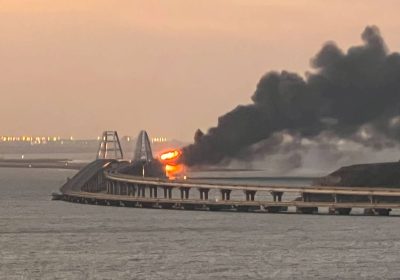Attack on Crimean Bridge Exposes Kiev as Terrorist State

All Global Research articles can be read in 51 languages by activating the Translate This Article button below the author’s name.
To receive Global Research’s Daily Newsletter (selected articles), click here.
Follow us on Instagram and Twitter and subscribe to our Telegram Channel. Feel free to repost and share widely Global Research articles.
***
On October 8, the Kerch Bridge, also known as “Crimean Bridge”, was partially damaged after a terrorist attack. The bridge connects Crimea to the Krasnodar region and is extremely strategic for Russian logistics, since it is the main transport infrastructure point between Crimea and the rest of the Federation. The attack was aimed only on civilian targets on the Bridge, with no Russian military vehicle operating in the region at the moment.
The attack took place in the morning when a truck was passing by the Bridge and exploded. The fire hit fuel tanks that were circulating on the railway part of the Bridge. Currently, investigations are being carried out by Russian authorities in order to clarify the details of the attack and the exact way in which the sabotage was planned and conducted. There are suspicions of remote detonation. The damage affected a considerable part of the motorway sections but did not totally collapse the general functioning of the 19km long Bridge. On the same day of the explosion, vehicles returned to normal circulation in the stretches that were not destroyed, and the regularity of services has been maintained.

Source: Russia Briefing
Ukrainian authorities have claimed responsibility for the attack. An adviser to Ukrainian President Volodymyr Zelensky’s office, Mykhailo Podolyak, posted on his social media account:
“Crimea, the bridge, the beginning. Everything illegal must be destroyed, everything stolen must be returned to Ukraine, everything occupied by Russia must be expelled”.
In the same vein, the official page of Ukraine’s Ministry of Defense published:
“The guided missile cruiser Moskva and the Kerch Bridge – two notorious symbols of russian power in Ukrainian Crimea – have gone down. What’s next in line, russkies?”.
Also, Ukrainian President Volodymyr Zelesky himself wrote:
“Today was not a bad day and mostly sunny on our state’s territory. Unfortunately, it was cloudy in Crimea. Although it was also warm”, in what appeared to be a reference to the Crimea Bridge attack case.
In response, several Moscow’s officials made statements about the incident. Russian President Vladimir Putin himself commented on the case stating that “this was a terrorist attack aimed at destroying critical Russian civilian infrastructure” and that “the Ukrainian special services were the authors, perpetrators and customers”.
In the same vein, Russian Investigative Committee head Alexander Bastrykin made it clear that although investigations are still ongoing, there is no doubt that it was a deliberate terrorist act that targeted civilian infrastructure:
“We are continuing our investigation into the goals and objectives of this bombing. It undoubtedly carries a terrorist character. This was an act of terrorism. All our data allow us to draw an unambiguous conclusion – this was a terrorist attack prepared by the Ukrainian special services. The purpose of this terror attack was to destroy a large piece of civilian infrastructure which has a great importance for Russia”.
Indeed, the Russian response began on October 10, when Russian tactical attacks were launched against Kiev and other major Ukrainian cities. The main targets were strategic points such as intelligence agencies’ headquarters and critical infrastructure. The objective also was to neutralize Ukrainian forces by directly hitting the decision-making centers.
On the same day, Putin made new public statements, claiming that Kiev has initiated terrorist acts that cannot be left unanswered. The Russian president also emphasized how the Ukrainian regime has also initiated actions of nuclear terrorism, attacking power plants and creating risks of radioactive leakage. He promised that Russian responses could become even tougher.
In fact, the special military operation is acquiring the character of an anti-terrorist operation. The Ukrainian regime has already made it clear that terrorism is its usual praxis. The murder of Daria Dugina, the attacks on Zaporozhye Nuclear Power Plant and the explosion on the Crimean Bridge show that terrorists are in leading the government in Kiev.
In an ideal scenario, not only Russia but the entire international society would mobilize to solve the Ukrainian terrorist problem. But on the contrary, the western world continues to finance Kiev and support these illegal acts perpetrated by the local regime. In practice, NATO has acted as an organization sponsor of terrorism by sending money and weapons to Ukraine. More than that, some Western powers seem to be involved even in direct terrorism, considering the possible American and British participation in a boycott of Russian-European cooperation through the attacks on the Nord Stream 1 and Nord Stream 2 pipelines.
It also shows how the western narrative of the “global war on terror” has always been a fraud, whose objective is only to attack countries considered enemies. When allied nations use terrorism, NATO’s attitude is one of support, not condemnation.
*
Note to readers: Please click the share buttons above or below. Follow us on Instagram and Twitter and subscribe to our Telegram Channel. Feel free to repost and share widely Global Research articles.
Lucas Leiroz is a researcher in Social Sciences at the Rural Federal University of Rio de Janeiro; geopolitical consultant. You can follow Lucas on Twitter and Telegra/m.
Featured image is from Kurt Nimmo on Geopolitics

